
3
5. Configuring through Web Browser………………………………………….. 15
6. Configuring through Telnet Connection…………………………………….. 16
7. Serial Line Interfaces…………………………………………………………. 16
7.1. Connector Pinout RS-232C, Port 1………………………………… 16
7.2. Connector Pinout RS-232C Port 2…………………………………. 16
7.3. Line Interface Description………………………………………….. 17
7.3.1. First Channel, RS-232C…………………………………… 17
7.3.2. Secondary RS-232C Interface……………………………. 18
8. Application Examples…………………………………………………………. 18
8.1. ASCII Terminal to Host for Login…………………………………. 18
8.2. Telnet Server for Device Management…………………………….. 18
8.3. Printer Connection………………………………………………….. 18
8.3.1. Software Handshake……………………………………………… 19
8.3.2. Printer Ready Signal……………………………………………… 19
9. LED Status Display…………………………………………………………… 19
9.1 LED Description
and
Functions …………………………………….. 19
10 Technical Data………………………………………………………………… 20
10.1. CPU, Memory Controllers ………………………………………… 20
10.2. Serial Interface……………………………………………………… 20
10.3. Network Interface………………………………………………….. 20
10.4. Power Supply……………………………………………………….. 20
10.5. Power Consumption…………………………………………………21
10.6. LEDs………………………………………………………………….21
10.7. Case…………………………………………………………………. 21
10.8. Dimensions ………………………………………………………….. 21
10.9. Weight……………………………………………………………….. 21
Appendix A……………………………………………………………………….. 22
A.1. IP Addressing……………………………………………………..… 22
A.2. Class A Network……………………………………………………. 22
A.3. Class B Network……………………………………………………. 22
A.4. Class C Network……………………………………………………. 22
A.5. Network Address…………………………………………………… 22
A.6. Broadcast Address…………………………………………………. 23
A.7. IP Netmask…………………………………………………………. 23
A.7.1. Standard IP Network Netmask…………………………………. 23
A.7.2. Netmask Examples……………………………………………….. 23
A.7.3. Private IP Networks and the Internet…………………………… 23
A.7.4. Network RFC’s…………………………………………………… 24
Appendix B……………………………………………………………………….. 25
B.1. Bin/DEC/Hex Table………………………………………………… 25




































